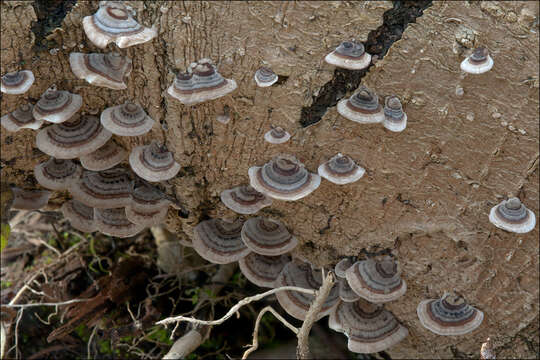Bjerkandera-adusta_4

Description:
Bjerkandera adusta (Willd.:Fr.) Karst., syn.: Boletus crispus Pers.Smoky Bracket, DE: Angebrannter RauchporlingSlo.: osmojena bjerkanderaThese were very young fruit bodies, with still white or pale gray pore surface, with very, very small still developing pores.Dat.: Dec. 09. 2014Lat.: 46.35624 Long.: 13.69918Code: Bot_854/2014_DSC5245Habitat: alpine valley, river bank, locally almost flat terrain, calcareous ground, river bank vegetation mostly consisting of Salix eleagnos, Picea abies and some Fagus sylvatica; humid air and ground, partly sunny, exposed to direct rain; average precipitations ~ 3.000 mm/year, average temperature 7-9 deg C, elevation 525 m (1.720 feet), alpine phytogeographical region.Substratum: dead wood, a stump of cut down Salix eleagnos in its late initial phase of disintegration.Place: Lower Trenta valley, left bank of river Soa between villages Soa and Trenta, 50 m downstream of the bridge to the farmhouse 'Matev', Trenta 3, East Julian Alps, Posoje, Slovenia EC.Comments: There exist two species of the genus Bjerkandera growing in Europe and also in Slovenia: Bjerkandera adusta and Bjerkandera fumosa. Both have very variable and irregular habitus and can be found pileate, effuse reflexed and also totally resupinate. Bjerkandera adusta is more common and can be distinguished from Bjerkandera fumosa by its very, very small more or less angular pores (5-7/mm), darker gray pore surface with pale margin and smaller spores. But distinguishing is not always easy. Bjerkandera adusta can be found during the whole year but it sporulates only at temperatures below 10 deg C (Ref.:4). So, one can hope to get spore print only during colder seasons of my country. Generally in the literature the pilei are described as azonate or only weakly zonate, however when they are very young this apparently doesn't hold (see Fig.4).Growing in imbricate groups of several fruit bodies; pilei 1.2 - 2.8 cm across, trama pale brown, corky-fibrous (cannot be chewed over but can be nicely cut with a razor), up to 4.5 mm thick, pore layer dark-grey and distinctly darker then trama, about 1 mm thick; stipe absent; taste mild, slightly unpleasant but not bitter; smell on sour earth similar to Trametes versicolor; SP faint, whitish. Spores smooth. Dimensions: 4.1 [4.5 ; 4.7] 5.1 x 2.6 [2.9 ; 3] 3.4 microns; Q = 1.3 [1.5 ; 1.6] 1.8; N = 37; C = 95%; Me = 4.6 x 3 microns; Qe = 1.6. Olympus CH20, NEA 100x/1.25, magnification 1.000 x, oil; in water, live material. AmScope MA500 digital camera.Herbarium: Mycotheca and lichen herbarium (LJU-Li) of Slovenian Forestry Institute, Vena pot 2, Ljubljana, Index Herbariorum LJFRef.:(1) J. Breitenbach, F. Kraenzlin, Eds., Fungi of Switzerland, Vol.2. Verlag Mykologia (1986), p 268.S (2) M. Bon, Parey's Buch der Pilze, Kosmos (2005), p 316. (3) L. Ryvarden, R.L. Gilbertson, European Polypores, part 1., Synopsis Fungorum 7., Fungiflora A/S (1993), p 168. (4) G.J. Krieglsteiner (Hrsg.), Die Grosspilze Baden-Wrttembergs, Band 1., Ulmer (2000), p 486. (5) A. Bernicchia, S.P.Gorjon, Cortitiaceaes.i., Fungi Europaei Vol.12., Edizioni Candusso (2010), p 139.
Included On The Following Pages:
- Life (creatures)
- Cellular (cellular organisms)
- Eukaryota (eukaryotes)
- Opisthokonta (opisthokonts)
- Nucletmycea
- Fungi (mushrooms, lichens, molds, yeasts and relatives)
- Dikarya
- Basidiomycota (basidiomycete fungi)
- Agaricomycetes (Mushroom-Forming Fungi)
- Polyporales
- Meruliaceae
- Bjerkandera
- Bjerkandera adusta
This image is not featured in any collections.
Source Information
- license
- cc-by-nc-sa
- copyright
- Amadej Trnkoczy
- photographer
- Amadej Trnkoczy
- original
- original media file
- visit source
- partner site
- Flickr Group
- ID


